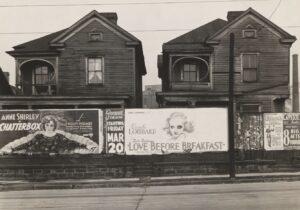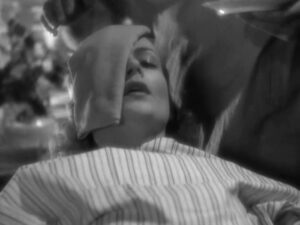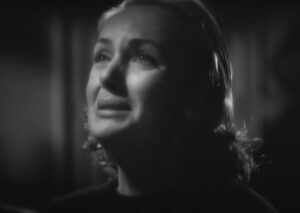One of the craziest moments in American cinema comes in Ernst Lubitsch’s nervy unclassifiable To Be or Not to Be (1942), when Carole Lombard, playing a famous Polish actress, pays a call on a Nazi (Stanley Ridges) at Gestapo headquarters. She has to stall for time and pretend-submit to his seduction. He kisses her, and you know she will wipe her mouth later. Lubitsch placed the camera at Siletsky’s back, and Lombard slowly emerges into view from the kiss, staring heavenward in a daze. She murmurs, “Heil Hitler.”
Watching eighty-two years later, one thinks, “… How did they dare?” Many critics at the time were not amused. There was nothing funny in 1942 about a Hitler look-alike responding to a volley of salutes with an awkward, “Heil myself.” Filmed before America entered the war, with three years of slaughter to go, To Be or Not To Be vibrates with dread for Europe’s plight, which makes Lombard’s “Heil Hitler” even more unhinged. It would be Lombard’s final film.
Her career was cut short on January sixteenth, 1942 when the plane transporting her back to Los Angeles crashed into a mountain outside Las Vegas. She was only thirty-three years old. Clark Gable was left a widower and, by all accounts, never fully recovered. Who would Carole Lombard have developed into as an actor? Would her quicksilver mania have found a place in the serious 1940s, in anti-social noirs, in the puritanical-yet-Freudian 50s? We’ll never know.
What we do know is there was no one like her. While you could say that about all the big female stars in Hollywood’s classic era – Barbara Stanwyck, Greta Garbo, Katharine Hepburn, Marlene Dietrich, Joan Crawford, Bette Davis — individuals, all; even their silhouettes were distinct – Lombard was the wild card of the bunch. She didn’t have a “persona,” like Marlene Dietrich did. She wasn’t self-invented, like Joan Crawford. She didn’t ooze European mystery, she didn’t arrive in Hollywood with Broadway credits. She was just herself, an original.
 From TO BE OR NOT TO BE
From TO BE OR NOT TO BE
Born Jane Peters in 1908, she spent her early years in Fort Wayne, before Mama Peters moved the family to California. Lombard had no ambitions, but the movies found her anyway. Director Allan Dwan described how he cast twelve-year-old Jane in a small role in A Perfect Crime (1921): “I saw a kid playing baseball on the street with some other kids. She was a cute-looking little tomboy, a hoyden, out there knocking hell out of the other kids, playing better baseball than they were. And I needed someone of her type.”
As a teenager, she whooped it up at the Cocoanut Grove, winning Charleston contests (alongside Joan Crawford). Her beauty caught the attention of Fox Film Corporation, which put her under contract. A car accident in the mid-20s left a scar on Lombard’s left cheek, visible even after reconstructive surgery, and Fox dropped her. The resilient Lombard joined Mack Sennett’s slapstick ensemble as one of his “bathing beauties,” and flourished in the atmosphere of camaraderie, even with the grueling schedule. Sennett’s comedy style required abandon. Lombard took to it.
Paramount signed Lombard to a contract and threw her into projects where her lack of experience is evident. In 1931 she made five movies, two of which, Richard Wallace’s Man of the World, starring William Powell, and Lothar Mendes’ Ladies Man (also starring Powell), show flashes of Lombard’s inventiveness. In Man of the World, there’s a scene where she stomps up the stairs at the racetrack, propelled forward by outrage and impatience. We will see this propulsive energy again and again. Lombard didn’t enter rooms. She burst into them like a whirling chaotic wave. Hers was not the gliding stride of a movie goddess. She moved with intention, always, even if (or especially if) her intention was ridiculous.
In Ladies Man, Powell plays Jamie, a gigolo “dating” a mother and daughter (Lombard) simultaneously, all while courting the sophisticated Norma (Kay Francis). Lombard is first seen leaning against the fireplace, looking, in her white satin dress, like one of Lee Miller’s solarized photographs. But looks deceive: Lombard moves like a gawky kid next to the womanly Francis. In one scene, drunk and inconsolable, Lombard sobs “Jamie!” over and over, but then, mid-sob, she gets distracted by the twisted straps on her dress. A lot of actors are so focused on the plot they forget reality. Even at her most insane Lombard never forgot reality. It’s what makes her so funny. The chemistry between Powell and Lombard was palpable: the two would marry shortly after the film’s release (and then divorce in 1933. They reunited onscreen in 1934 in the mighty My Man Godfrey.)
Most actors need a “break,” but Lombard needed more, she needed a paradigm shift in the industry. It came in 1934. Two films, Frank Capra’s It Happened One Night and Howard Hawks’ Twentieth Century, ushered in screwball comedy, the oxygenated antidote for the grim 1930s.
Screwball comedy’s supremacy was brief — its meteoric rise began in the mid thirties and reached its apex before the next decade, and was, ultimately, an anomaly in Hollywood’s history. The earliest years of sound film changed how stories were told. Writing rose in prominence, and some of the best East Coast talents were drawn to the money on the opposite coast. The early ‘30s were the bleakest years of the economic crash. Film reflected the desperation — musicals like Gold Diggers of 1933 is a delicious example. Organized crime in America was an epidemic, dating from the 1920s prohibition of alcohol, and gangsters and bank robbers had glamorous reputations (John Dillinger’s crime wave took place mostly in 1933-34: it’s not hard to understand why he became a folk hero. Banks were the enemy.) Before the Motion Picture Production Code, known as the Hays Code, imposed censorship guidelines, things like crime, sex trafficking, prostitution, drug addiction, and poverty, were portrayed with no euphemism. Some of these films — Baby Face, Public Enemy, Three on a Match, The Story of Temple Drake — are still shocking today. Even more shocking, these films contain critiques of the capitalist system. The Code put a lid on all of it. But there were other factors at play in the sudden rise of screwball. The public was exhausted. They didn’t need reminders of how difficult life was. They wanted an escape. (The collaboration of Fred Astaire and Ginger Rogers, in whose films the Depression doesn’t exist at all, was the biggest box office draw in the ‘30s.)
The talented writers flocking to Hollywood wiggled around the Code using double entendre, sexual innuendo, and wit — all important elements in screwball. Screwball comedy dealt with romance and often featured couples reuniting after an estrangement (The Awful Truth, His Girl Friday), known as the “comedy of remarriage.” The “remarriage” part of it meant that nobody was a virgin, and therefore sexual knowingness was on the table. Innocent ingenues were out. The class consciousness in the pre-Codes morphed into what Stephen Ross calls in his book Working Class Hollywood the “cross-class fantasy,” in which an heiress falls for a common man, or an oil magnate falls for a switchboard operator (etc.) It Happened One Night established the formula: an heiress (Claudette Colbert) and a reporter (Clark Gable) repeatedly butt heads and sling insults, all while avoiding the obvious: they are madly in love.
The formula had been done by Shakespeare to perfection with Beatrice and Benedick in Much Ado About Nothing, and all screwball was a variation on the theme. Screwball required actors who could speak (and think) fast. In an 1896 letter to actress Ellen Terry, famous for her Beatrice, George Bernard Shaw gave tips on playing Shakespeare: “Play to the lines, through the lines, but never between the lines. There simply isn’t time for it.” There wasn’t time in screwball either. The fastest screwball dialogue was probably in His Girl Friday, but Carole Lombard was the fastest thinker (and talker) of them all. She followed Shaw’s dictum as though born to it, tossing herself into silliness with such abandon she left everyone staggering in her dust. She is screwball’s pinnacle. Screwball is cathartic because we watch people trying to maintain their dignity as they fall in love. Lombard was different. She had no dignity to lose.
Although she helped usher in the genre, and became its reigning monarch, it didn’t click for her right away. She needed a push.
The push came from Hawks (coincidentally, Lombard’s second cousin). He recalled seeing her at a party, tipsy, funny, trash-mouthed, and he realized no movie had ever captured her properly. Hawks saw what Allan Dwan saw. A woman like Lombard – a feisty feminine tomboy – was Hawks’ ideal, a type he explored in film after film. Hawks put her in Twentieth Century, based on Ben Hecht and Charles MacArthur’s play, about a Broadway impresario trying to win back the diva whom he made a star.
Lombard was hesitant at first in Twentieth Century. She was twenty-five years old, going up against John Barrymore, still a towering legend despite his alcoholism. Hawks said years later: “She was trying very hard and it was just dreadful.” He pulled her aside and asked her what she would do if someone spoke to her the way Barrymore did. Lombard said, “I’d kick him in the balls.” Hawks told her to “quit acting” and kick Barrymore, otherwise he’d fire her. She returned to the scene, and went for it, leaning back on the couch, kicking her legs up, little knife jabs at Barrymore’s stomach. Barrymore looks stunned. As good as Lombard was in some of her early-30s films – No More Orchids (1932), No Man of Her Own (1932, opposite future husband Clark Gable), Virtue (1932), Brief Moment (1933) – her rapid transformation in Twentieth Century is jaw-dropping. It’s a whole different actress.
The film opened on May 3, 1934, acclaimed by critics but not exactly a hit. It would be two more years until My Man Godfrey. She continued to be under-used or mis-used (Now and Forever, The Gay Bride, Rumba), but then something magical happened. The movies caught up to her.
Writer Dan Callahan calls Mitchell Leisen’s Hands Across the Table (1935), “the first real Carole Lombard movie.” It put her opposite Fred MacMurray for the first time (they would make four films together). Powell and Lombard’s chemistry was soft and tender, while MacMurray and Lombard’s was mischievous and madcap, two playmates up to no good. In Hands Across the Table, Lombard has a crust of street-smarts, but she’s capable of melting. Nobody melted like Lombard. Walter Lang’s Love Before Breakfast(which gave this column its name) is screwball-adjacent, but sometimes flat in execution. (In one scene, Lombard gets a black eye, a moment immortalized in the film’s famous poster, which was captured by Walker Evans in his 1936 photo “Houses and Billboards in Atlanta”).

Walker Evans. Houses and Billboards in Atlanta. 1936
Clothes draped on Lombard’s slim frame beautifully, but, as with the straps in Ladies Man, Lombard was not dominated by her wardrobe. Her clothes were more like props. Travis Banton, the gifted costume designer at Paramount, understood Lombard’s screen essence. She looked sensational in anything he put her in, from gowns to jodhpurs, turtlenecks to smart suits, but he also put her in a hat with a feather plume three feet high in Love Before Breakfast. Even her clothes had a sense of humor.

From LOVE BEFORE BREAKFAST
In My Man Godfrey, directed by Gregory La Cava, everything came together for Lombard, and for everyone else too. His Girl Friday is exhilarating because Cary Grant and Rosalind Russell are equals in verbal dexterity and ferocity. In My Man Godfrey, Lombard’s Irene is an incoherent wreck, falling in love with Powell’s Godfrey so completely she never gets her balance (Irene doesn’t have “balance” to start). Irene is first seen bursting out of the car in true Lombard fashion, like the whirling foam of champagne bursting from the bottle. She’s unstoppable. Poor Godfrey doesn’t stand a chance.
Irene is in a state of lunatic adoration throughout, vacillating wildly between hope and despair. When Lombard was hopeful, her whole body and spirit strained upwards, and when she was discouraged, she deflated completely. She is at the mercy of her inflations/deflations. Godfrey rejects her advances, and she collapses into a somnambulistic daze. Nobody can shake her out of it. “What is food?” she drones tragically when someone mentions lunch. If we all fell in love like this, the world would shriek to a halt. Irene is so in love it appears she has no bones. She loves Godfrey so much her skeleton dissolves.
My Man Godfrey was a massive hit, and Lombard was nominated for an Oscar. She owned the late 1930s and was, for a time, the highest paid actress in Hollywood (thanks to her crack negotiating skills). She hand-picked creative teams – cinematographers, lighting designers – making her, essentially, a producer. In an interview, Lombard said she had no interest in directing, but “I think I’d [like to] be David Selznick.” Selznick himself wrote to Lombard in 1940, saying, “I have always held you up as the shining example of what a joy it can be to work with a star when that star appreciates a producer’s problems and cooperates in their solution.”
In 1937, she worked with William Wellman for the first and only time, in the Technicolor Nothing Sacred, a vicious satire of journalism and the gullible public. Fredric March plays Wally, a reporter reviving his career with a phony story about a woman named Hazel (Lombard), dying of radium poisoning. She is not, in fact, dying, but the public has so fallen in love with her “courage,” and so in love with themselves for their own compassion, Hazel has no choice but to play along. The hoax reaches absurd proportions, and Hazel is torn asunder by guilt and dawning love for Wally. When Wally finally kisses her, it’s like everything is drained out of Hazel except for love. Nothing Sacred has real bite, even more so now in the hellscape of social media and #fakenews.

From MADE FOR EACH OTHER
Lombard’s filmography contains under-seen gems like 1937’s True Confession, again opposite MacMurray, or, John Cromwell’s Made for Each Other (1939), where a young couple (Lombard and James Stewart) struggles during the first year of marriage. Made for Each Other is not un-humorous but it isn’t a screwball, and the final sequences require a lot of Lombard emotionally. Her work is grounded and naturalistic. The Depression was mostly over and Germany was on the move. Screwball dimmed its marquee. Many 1930s stars couldn’t transfer into the 1940s. Lombard, newly wed to Clark Gable, had other priorities: her marriage was difficult, she wanted babies. To Be or Not to Be was a surprising choice to some: it was not a star vehicle, and Lombard was just another member of the ensemble (Jack Benny, Sig Ruman, Felix Bressart, Robert Stack). Lombard embraced the experience. Lubitsch and Lombard was a match made in heaven and we’re lucky it happened at least once.
In the pantheon of screwball dames, Lombard was the mushiest, the most romantic. Lombard’s swoons were almost Garbo-like in their totality. Garbo’s swoons were archetypal, and infused with an awareness of fate and mortality. In other words, they were European. Lombard’s swoons were un-distilled pure-bred American, with no hint of loss, no sense of impending doom. Her swoons were upward-facing, always, her energy propelling itself forwards, face lifted to the heavens, eyes pinwheeling in ecstasy.
It’s a tragedy Carole Lombard was forced to come down to earth so soon.
